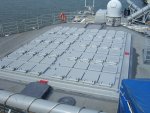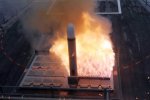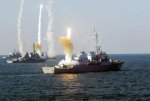I read the articles etc and its informative, and does list some valid concerns. The problem however, with the DF-21D is basically that its course correction abilities are "limited" to a certain degree that it seriously hampers the ability for the missile to actually carry that many warheads due to size and whatnot. But the RDN (Royal Danish Navy) newest 3 frigates are actually "armed" with a full AA suite etc with a rather advanced radar array against airborne threats and what not. According to what I can gather on the wire they should be the most state-of-the-art ships of the worlds today in regards to production and the hardware they carry on board. But obviously doesn't carry the firepower of an old WW2 Battlecruiser etc  . And the Australians are building a number of them as well, perhaps not the exact same ship, but ships of comparable types that can fitted as they are needed.
. And the Australians are building a number of them as well, perhaps not the exact same ship, but ships of comparable types that can fitted as they are needed.
So I would think a combined NATO strikeforce would stand a fair chance of knowing such a missile was launched if it ever happened and then either start steaming out of the way or deploy adequate countermeasures. But only one way to truly know and that is a direction I hope we never head into. Because just look at wargames, no one wins a nuclear war per say.
@Peashooter
I thought the Arleigh Burke class was outdated by our present standards and some newer destroyer blood might be needed?. Unless they are talking about using the Arleigh Burke frame and then outfitting it with recent and up-to-date electronics etc?. But I have always wondering why the americans never seemed to buy into the StanFlex concept since that would make more or less any fleet more versatile etc. StanFlex is basically a "standard" that outfits ships with hardpoints, like on a fighter, and these hardpoints can be outfitted as pr mission profile by dropping in a new module. So for instance an Arleigh Burke could be outfitted with an AA pod, Missile Shield pod, ASW Pod and so on, depending on its present assignment. Problem that be is that if the mission changes midway you are sorta stuck with the things on board, but you are anyway if all the gear is hardfitted to the ship.
But I figure its down to philosophy and what you really want.
So I would think a combined NATO strikeforce would stand a fair chance of knowing such a missile was launched if it ever happened and then either start steaming out of the way or deploy adequate countermeasures. But only one way to truly know and that is a direction I hope we never head into. Because just look at wargames, no one wins a nuclear war per say.
@Peashooter
I thought the Arleigh Burke class was outdated by our present standards and some newer destroyer blood might be needed?. Unless they are talking about using the Arleigh Burke frame and then outfitting it with recent and up-to-date electronics etc?. But I have always wondering why the americans never seemed to buy into the StanFlex concept since that would make more or less any fleet more versatile etc. StanFlex is basically a "standard" that outfits ships with hardpoints, like on a fighter, and these hardpoints can be outfitted as pr mission profile by dropping in a new module. So for instance an Arleigh Burke could be outfitted with an AA pod, Missile Shield pod, ASW Pod and so on, depending on its present assignment. Problem that be is that if the mission changes midway you are sorta stuck with the things on board, but you are anyway if all the gear is hardfitted to the ship.
But I figure its down to philosophy and what you really want.









